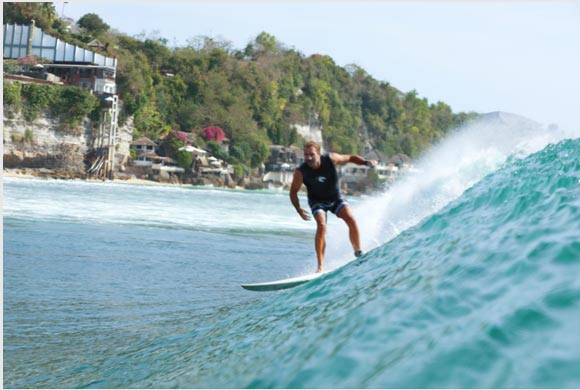HOW TO PADDLE ON A SURFBOARD

SURF TECHNIQUE: HOW TO PADDLE ON A SURFBOARD
The Proper Paddle Technique Explained
Paddling is arguably the most important aspect of surfing. In fact, we probably spend 90% of our time in the water on our stomachs paddling, not on our feet riding waves. So, whether you are you a beginner surfer who can’t seem to figure out a natural paddle technique, or you’re an intermediate or an advanced surfer who always seems to run out of steam on tough paddle outs, improving your paddle technique will ensure you have a better time in the water.

Either way, this article ‘how to paddle on a surfboard‘ is for you. Learn the proper technique that will have you gliding, streamlined on top of the water’s surface, and save your shoulders from that dreaded burnout pain. Whether you’re paddling out right in front of our Caribbean surf camp, or your surfing at home, these tips will help get you to the lineup as quickly as possible, fresh, and ready surf.
HOW TO PADDLE ON A SURFBOARD
START WITH A PROPER WARMUP
Paddling can be a bit of a workout, so you should warm up accordingly. Either when you hit the sand, or before you head out of the surf camp. When you paddle, you engage your shoulders and upper back, so be sure your warm-up activates both of those muscle groups.
Additionally, when you paddle, sit in the line-up, and ride waves, your hips are in a closed and locked position. It is crucial for longevity to perform exercises and stretches that will open your hips.
TIMING IS EVERYTHING, DON’T RUSH
When you arrive at the beach and strap your leash on, don’t just sprint into the water and start paddling madly. Relax, sit down, maybe stretch a bit, but most importantly watch the water.
What are the waves doing? How often are sets coming? Is there a channel to paddle out in? These are all things you must ask yourself and answer before entering the water. Wait for a lull between sets, and head into the water. Walk your board out until you’re in about chest deep water and then hop on and paddle.

POSITION YOURSELF ON THE BOARD CORRECTLY
Bad positioning plagues many beginner surfers, causing unnecessary drag and therefore hardship during their paddle out. If you’re too far towards the back of the board, the nose of your board will tilt up in the air, slowing your paddle.
Contrastingly, if you’re too far forward on your board, the nose of the board will sink underwater causing unnecessary drag. Find that sweet spot on your board, where the nose is gliding just above the surface, in calm water and remember where you are in reference to a marking on the board (like the logo).
ELONGATE YOUR REACH WITH EACH STROKE
Like swimming, when you learn how to paddle on a surfboard, your body should be as long and stretched out as possible.
With each stroke, you should extend your arm to its furthest possible length. Short and rapid movements will leave you exhausted, while long reaching strokes will send you forward, gliding efficiently over the surface of the water.
MOVE SLOWLY
Have you ever heard the phrase, “Slow is smooth, smooth is fast?” It applies directly to paddling. If you’re at a full sprint trying to paddle out, you won’t make it. You will tire long before you reach the lineup. Slow and smooth long reaching strokes will propel you quickly and efficiently.
DON’T OVERREACH ON THE FOLLOW-THROUGH

When you’re executing the “pull” phase of your paddle stroke, be sure not to drag your hands too far back causing downward (not forward) momentum that will slow your paddle. To execute proper paddle technique, pull your stroke back to chest level, then lift your arm straight out of the water and repeat. When you pull further than your chest, the last portion of your stroke will push your board downward causing you to lose your momentum with each stroke.
KEEP YOUR ELBOWS HIGH
If you watch 11-time world champion surfer Kelly Slater paddle, you’ll notice how effortlessly he moves through the water. Part of his technique that stands out is that he consistently keeps his elbows high. From the moment Kelly brings his hands out of the water, to the moment he extends his reach, he leads with a high elbow. Keeping your elbows high will increase the effectiveness of each stoke, by keeping your hand and forearm in the vertical position from the start of the stroke. Essentially, it will allow you to move more quickly with less effort.
DRAG YOUR THUMBS
This tip goes hand in hand with the previous tip of keeping your elbows high. If you keep your elbows high, your hands will naturally be low. The idea here is to not bring your hands too far out of the water. When your hand exits the water, it should almost drag on the surface next to you as you bring it forward for the next stroke. By dragging, or nearly dragging, your thumbs in the water as you bring your hands forward for each stroke, you save energy by not engaging your traps. This will allow you to paddle harder for longer and prevent you from burning out due to soreness.
KEEP YOUR LEGS AND FEET IN CONTROL
While it may be instinctual to kick and try to propel yourself forward, it will actually slow you down. Instead, keep your feet together with your ankles side by side as you paddle. While kicking your feet might help shift your weight forward to actually catch a wave you’re paddling for, when you’re paddling out you do not want your weight too far forward. So, keep those feet still!
KEEP YOUR HEAD STILL
Again, if you watch world champ surfer Kelly Slater paddle, his head is still. This may seem inconsequential, but it has a tremendous effect on speed and efficiency in the water. Any swimmer will tell you that keeping your head still will keep your weight centred, not moving it from side to side, reducing drag and increasing speed. The same principle obviously applies to surfing. If your head moves to you right, your body will follow, taking you off your trajectory, digging your rail into the water, and ultimately slowing you down.
YOUR SPINE IS YOUR FULCRUM
Similarly, to swimming when you paddle, your spine acts as a fulcrum as your body moves ever so slightly from side to side with each stroke. This slight movement is not intentional, but a byproduct of the reach. To ensure you’re moving correctly, it is best to envision you are moving with a metal rod going through your body from head to tailbone. As stated previously, your head should stay still while you reach out each stroke.
SPOT THE WAVE AND REACT
The final step to a good paddle out is a proper duck dive or turtle roll. As you paddle out, constantly look out to sea for oncoming waves. When you spot a wave headed your direction, whether it is whitewater or a cresting wave, you’ll want to initiate your duck dive or turtle roll approximately 2 meters from the breaking wave.
VIDEO HOW TO PADDLE ON A SURFBOARD
Just like with any aspect of surfing, practice makes perfect. The best exercise for increased paddle strength and efficiency is paddling out to surf as often as possible. Now that you’ve learned how to perfect your paddle technique, take the next step in progression and learn to properly duck dive and turtle roll by checking out our blog on paddling out!
ESSENTIAL TIPS FOR IMPROVING SURF PADDLING TECHNIQUE
Mastering your paddling technique can significantly boost your performance on the waves. These tips will transform how you move through the water, making every paddle count for more speed and efficiency.
KEEP THE NOSE OF YOUR SURFBOARD SLIGHTLY OUT OF THE WATER
Elevating the surfboard’s front slightly above the water surface is a fundamental technique for any surfer. This beneficial method lowers friction and drag, permitting you to paddle with enhanced speed and negligible effort.
Ideally, keeping the board’s top portion 2-5 cm (approximately 1 or 2 inches) out of the water hits the sweet spot between maintaining buoyancy and improving control while paddling.
Lifting the board’s front just a tad can dramatically uplift your paddling efficiency, making wave traversing to reach the crest easier.
Creating this gentle lift demands core resilience and exact body positioning. Engaging your core stabilizes your torso, which consequently aids this mild altitude. Such precision improves your ability to move swiftly on water and furthers maneuverability when aligning yourself for incoming waves.
In addition, mastery of this skill contributes significantly to energy conservation during extended surf sessions or when confronted with tough conditions at sea.
Benefits of keeping the board’s nose elevated
Keeping your surfboard’s nose slightly elevated above the water substantially enhances paddling speed by lowering resistance. This strategic maneuver aids surfers to move over the water effectively, preserving energy for prolonged periods or swift actions.
By keeping this position, you marry your spine with your rib cage and scapula, which is instrumental for comfortable paddling experiences. Engaging in back-endurance exercises like swimming or pull-ups fortifies extensor chain muscles, boosting comprehensive performance.
Consistent stretching exercises ensure a full range of motion during each paddle stroke for upper body flexibility.
Inclusion of pulling exercises in training schedules cultivates strength and power necessary for effective paddling. These activities also boost stamina, enabling surfers to uphold the best form throughout their time in the water without rapid exhaustion.
Energy system training is crucial in this scenario; it grooms the body to utilize oxygen more successfully during strenuous physical activity like surfing. In turn, each paddle stroke becomes more forceful and effective, moving the surfboard ahead with lesser effort from the surfer.
Keeping the feet united better emphasizes this process by decreasing counteraction against water flow across the board’s features that are created particularly to smoothly cut through the ocean waves.
KEEP YOUR CHEST UP
Elevating the nose of your surfboard establishes a solid foundation for efficient paddling, but lifting your chest is similarly critical. This stance ensures right body positioning and balance on the board.
With your chest raised, you rely predominantly on your belly, making sure not to press down with your pectoral muscles. This position prevents potential injuries by aligning the spine and shoulders accurately and also involves the core muscles significantly.
The action of keeping an upright chest while paddling improves breathing capabilities — vital for endurance in long surf sessions. Superior breath control means you can paddle for extended periods without exhaustion, preserving energy for wave-catching.
Furthermore, this posture ameliorates your view of upcoming waves and intensifies vicinity awareness, necessary for both safety and strategic positioning in the water.
BENEFITS OF MAINTAINING AN UPRIGHT CHEST DURING PADDLING
Maintaining an upright chest while on your surfboard significantly improves balance and stability. This posture engages the core strength more effectively, leading to improved stroke mechanics.
Consequently, each paddle stroke is more powerful, enabling you to move through water with less exertion. This stance also decreases the likelihood of injury by reducing strain on the back and shoulders.
Keeping the chest up allows you to maintain a streamlined position in the water, which noticeably reduces drag and saves energy for extended surfing sessions.
This method enhances paddling efficiency and also fosters superior performance during surfing activities. With improved stability and fewer efforts from paddling, you’ll have more energy to improve techniques like exhaling during underwater diving, or executing sharp turns.
The secret is to use core muscles effectively, which leads to better control over the surfboard design under different wave conditions. The next suggestion is to concentrate on lower body positioning, specifically keeping your feet together while paddling, to further refine performance on the waves.
KEEP YOUR FEET TOGETHER
Keeping your feet together while you paddle on your surfboard might seem a minor detail, but it leads to significant improvements in your surfing technique. This position minimizes resistance in the water, allowing for more fluid movements.
It’s not just about reducing drag; this posture aids in maintaining stability and control over your board. With feet together, surfers find that their weight distribution becomes more balanced, enhancing both speed and directional control as they glide across the waves.
The smallest adjustments often lead to the most impactful enhancements in performance.
The benefits extend beyond immediate performance gains. Surfing with feet together reduces the risk of lower body injuries by preventing awkward strains during high-intensity paddling sessions.
For those long days at surf camp or an intense surf trip aiming to catch wave after wave, conserving energy becomes crucial. Adopting this seemingly simple habit can make a substantial difference in stamina preservation and injury prevention, ensuring you get the most out of every session on the water without taxing your body unnecessarily.
BENEFITS OF KEEPING FEET TOGETHER WHILE PADDLING
Keeping your feet together while paddling on a surfboard improves stability and control. This position aids in maintaining a centred body stance, essential for efficiently traversing the waves.
By reducing drag, it enables surfers to move through the water more smoothly, preserving energy for extended sessions in the ocean. This technique also significantly contributes to enhancing overall paddling performance by endorsing a streamlined body shape.
Such positioning is fundamental for generating more power and speed during each stroke.
The skill of a surfer to keep their feet together refines their technique and significantly aids their balance on the board. It prevents unnecessary movements that could lead to falls or loss of momentum when catching waves.
Enhancing this skill ensures that every paddle propels them nearer to an ideal takeaway point with less effort and higher efficiency. Progressing forward, perfecting this part of surfing will surely lead to more entertaining and successful rides across the ocean’s surface.
Importance of Practicing These Techniques
Perfecting these surf paddling techniques is vital for anyone aiming to hone their skills on the water. With regular practice, surfers will discover that they move through the ocean more effectively, and also relish a vastly improved surfing adventure.
Effective paddling approach
Mastering an effective paddling technique is crucial for catching waves and enhancing your surfing experience. By focusing on rail surfing, coaches help surfers understand how to manoeuvre their boards with precision.
The key lies in regular practice, especially on non-barreling waves which prepare surfers for more challenging conditions. This preparation boosts takeoff make rates notably in wave pools where timing and positioning are everything.
An effective paddling approach also involves a careful balance of energy conservation. Swimmers know the importance of keeping their feet together—a principle that holds true in surfing as well.
This technique minimizes drag, allowing you to glide through the water more efficiently with less effort on each stroke of your arms. As a result, you can spend more time out there doing what you love—surfing—and less time feeling fatigued or frustrated.
QUESTIONS
-
WHAT’S THE BEST WAY TO CATCH WAVES WITH PADDLING?
Timing and commitment matter most. Spot the wave early, turn your board, and paddle hard with full strokes. Once you feel the wave lift your board, give 2–3 extra strong strokes before popping up. Many beginners stop paddling too soon—that’s why they miss the wave.
-
HOW LONG DOES IT TAKE TO GET GOOD AT PADDLING?
If you surf regularly, your paddling improves within weeks. But getting truly efficient takes months of water time. Most new surfers underestimate how much paddling is involved—surfing is 90% paddling, 10% riding waves. At Swell Surf Camp, we accelerate the learning curve by correcting small mistakes early so you don’t waste energy.
-
HOW CAN BEGINNERS IMPROVE THEIR PADDLING STAMINA?
You don’t need a gym membership—practice is best done in the water. But swimming laps, push-ups, and light cardio will help. When you surf, focus on steady, relaxed paddling rather than sprinting for every wave. Beginners often burn out fast because they paddle too frantically. Learn to conserve energy.
-
HOW DO I PADDLE FASTER ON A SURFBOARD WITHOUT GETTING TIRED?
Speed comes from technique, not brute force. Keep your body streamlined, pull deep strokes close to the board, and avoid splashing. Sprint only when you’re actually catching a wave—otherwise, maintain a steady pace to save energy. Most beginners waste power paddling too hard all the time.
-
WHAT COMMON PADDLING MISTAKES SHOULD NEW SURFERS AVOID?
Lying too far forward (nose digs underwater) or too far back (board drags).
Splashing with arms instead of pulling long strokes.
Dragging feet in the water.
Stopping paddling too early when catching a wave.
Fixing these basics will instantly improve your wave count.
-
HOW CAN I AVOID SHOULDER PAIN WHEN PADDLING A SURFBOARD?
Overuse and poor technique cause shoulder pain. Keep your elbows slightly bent and your strokes smooth, not jerky. Also, don’t let your hands cross over the center line of your board. At Swell, we also stress stretching before and after surfing—flexibility prevents injuries just as much as strength does.
-
SHOULD MY LEGS BE IN OR OUT OF THE WATER WHEN PADDLING?
Your legs should be relaxed and kept together on the board. Beginners often drag their feet, which slows them down. Keep your toes just out of the water, and if you need extra balance, you can lightly cross your ankles. This helps streamline your body and makes every stroke more effective.
-
HOW DO YOU PADDLE CORRECTLY ON A SURFBOARD?
The key is positioning. Lie flat, chest slightly raised, and keep your nose about 2–3 inches above the water. Cup your hands and pull deep, smooth strokes close to the board. Don’t “splash” with your arms—paddle from your shoulders with controlled, efficient movement.
-
IS PADDLING ON A SURFBOARD SIMILAR TO SWIMMING?
Yes and no. The motion looks like freestyle swimming, but your chest is lifted and your body is balanced on the board, so it feels different. The big mistake swimmers make is using short, shallow strokes. On a surfboard, you want long, strong pulls with full shoulder rotation.

This article on how to paddle on a surfboard is part of the surf technique series for beginners.
Other articles in this series are:
- SURF TECHNIQUE: HOW TO DUCK DIVE AND TURTLE ROLL
- SURF TECHNIQUE: THE POP UP
- SURF ETIQUETTE: THE GOLDEN RULES
- SURF TECHNIQUE: CHOOSING THE RIGHT SURFBOARD
- BEST BEGINNER SURFBOARDS
More info on external websites about how to paddle on a surfboard:
Interested in learning all the essentials of surfing in an action packed water sport holiday in the Caribbean? Have a look at the surf holiday packages we offer, inlcluding our 1 week learn to surf holiday
-
WHERE IS SWELL LOCATED?
Swell Surf camp is located on the North coast of the Dominican Republic, right in the center of the cool surfer town of Cabarete. With 3 international airports to choose from it's also one of the easiest places to get to for a quick surf getaway. Puerto Plata Airport is only 25 minutes away from Swell. On the' getting here' page you'll find the different options of getting to us.
-
ABOUT SWELL SURF CAMP
Founded in the winter of 2009, Swell Surf Camp emerged from Jeroen and Clare Mutsaars vision. They lived in the Dominican Republic for eight years and spotted a gap in the surf camp market for higher quality accommodations combined with an engaging social atmosphere. Their extensive travel and stay experiences across different countries like Costa Rica, Nicaragua, Peru, Hawaii, Indonesia and various European nations fueled their passion to elevate the surfing retreat experience.
Swell Surf Camp is renowned as the world’s first luxury surf camp tailored specifically for beginners. The founders collaborated with a notable Swiss architect to design facilities that blend comfort with style. This innovative approach ensures every guest enjoys superior lodging and amenities. Since its inception, Swell has taught over 9,000 people how to surf with an emphasis on safety, fun, and structure.
Our achievements speak volumes. Swell has collected numerous accolades and maintains hundreds of stellar reviews from guests globally. Recognized repeatedly as the leading destination for luxury surf vacations, our commitment to excellence keeps us at the forefront of the industry.
Beyond surfing, Swell offers a diverse range of activities including kitesurfing, wingfoiling, and yoga classes. Guests can also enjoy horse riding both on scenic beaches and mountain trails—plus exciting adventure-filled excursions like canyoning.
A crucial element of any vacation is food, and here at Swell we excel. We provide delicious home-cooked meals daily. For evenings out, guests find themselves just minutes away from an array of dining options that promise satisfying culinary adventures.
For those who prioritize upscale amenities and wellness in a unique setting built around learning surf skills amid profound natural beauty, Swell should be on the top of your surf destination list
-
WHAT TO EXPECT FROM A 1 WEEK LEARN TO SURF HOLIDAY
Dreaming of catching your first wave but wondering if surf lessons are really for you? At Swell Surf Camp, our lessons are designed specifically for beginners, and we mean absolute beginners, particularly those between 40 and 55 from cities like New York, Boston, or Toronto. You’ll never feel rushed, lost, or out of place. Our expert instructors genuinely love teaching, and their approach is as much about encouragement as it is about skill-building. Every instructor carefully tunes each lesson to fit one person, you, so you always get personalized support, whether you’re working on basic paddling, learning to pop up, or building confidence in the water.
The journey at Swell Surf Camp is about progression, not perfection. You’ll start with the very basics, practicing on the sand before moving into gentle ocean waves with your instructor right beside you. Throughout every lesson, our focus is on clear communication, safety, and keeping things fun. As you progress, our instructors give you feedback in real-time, helping you celebrate small wins and guiding your next steps. You’ll learn solid surfing foundations, water safety, and even the unwritten rules of surf culture. By the end of your stay, you’ll be amazed at your own growth and how natural surfing feels. Don’t wait to discover how transformative a single lesson can be, book your surf adventure at Swell Surf Camp and let your surfing journey begin!
-
WHAT SPORTS DOES SWELL OFFER?
It's not only surfing that's on offer at Swell, we also offer learn to wingfoil and learn to kitesurf packages.





